#17th c. india
Text

Jusuf and Zuleykha by Muhammad Nadir Samarqandi, 1630s; Mughal Indian art
37 notes
·
View notes
Text
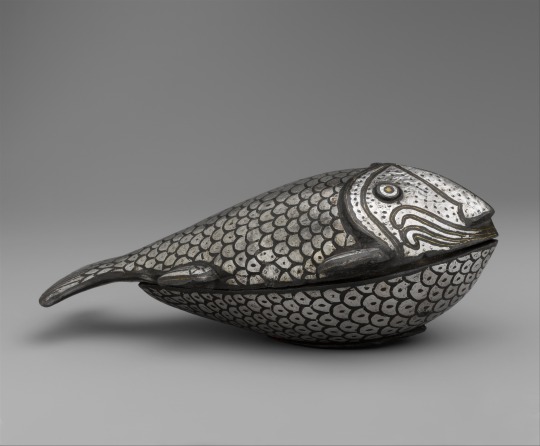
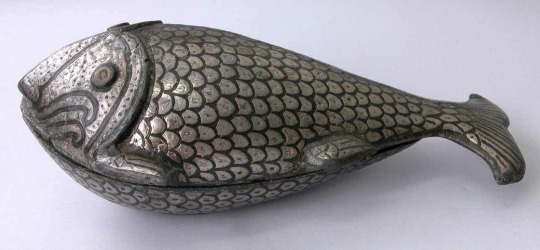
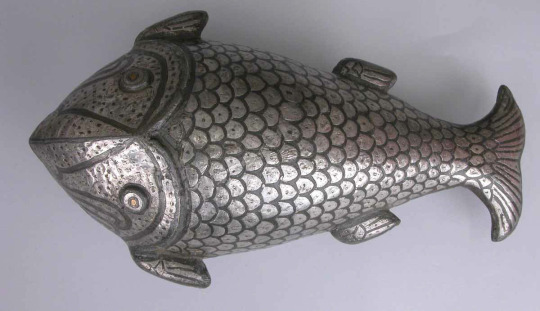
#FishFriday:
Fish-Shaped Box
Probably made in India, Lucknow or Hyderabad, 19th c.
Zinc alloy; cast, engraved, inlaid w/ silver & brass (bidri ware)
L 9 1/4 in (23.5 cm)
The Metropolitan Museum of Art, New York 19.135.15a, b
“Although the technique of inlaying metal known as bidri was invented in the Deccan in the 17th century, and Hyderabad remained a center for this type of metalwork into the 1800s, Lucknow, in northeastern India, also became an important center for production of bidri ware in the 18th and 19th centuries.”
#animals in art#fish#metalwork#bidri ware#Indian art#South Asian art#19th century art#box#effigy vessel#Metropolitan Museum of Art New York#Fish Friday
351 notes
·
View notes
Text
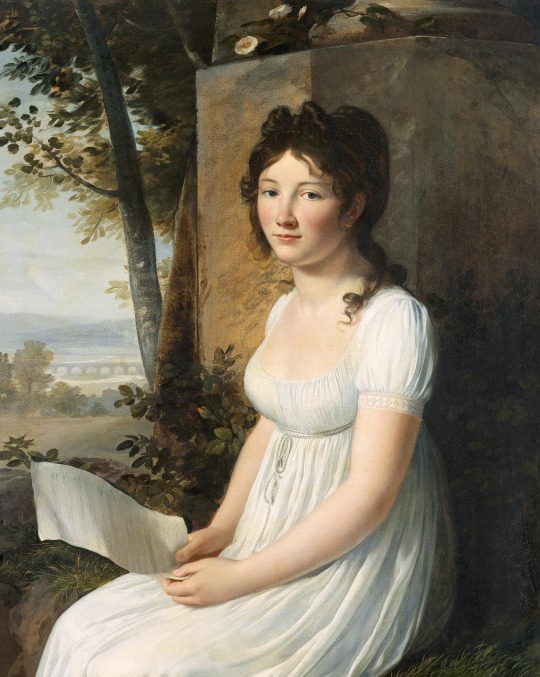
(Portrait of a young lady c. 1800-1805. Louis-André-Gabriel Bouchet. Fondation Napoléon, Paris.)
Flimsy Female Fashion in the Age of Napoleon
From NGV:
The garments worn by fashionable young women following the Revolution were famously dominated by muslin. In imitation of the ancient Greeks and Romans whose simplicity and elegance of dress was synonymous with democracy and the Roman Republic, post-Revolutionary Fashion set itself in opposition to the opulent artificiality of the Ancien Régime with its hooped and panniered skirts and elaborate embroidery and trimmings, by strutting a pared down simplicity in both style and material. Simply gathered, high waisted dresses of fine soft fabric, especially muslin, became the rage. The French interpretation of these classical garments came to be known as Empire style, whereas in England it became known as the Regency style. While muslin was the preferred fabric it came to have political and economic ramifications that were highly problematic for Napoleon.
Muslin is most typically an unbleached or white cloth, produced from finely combed cotton yarn. It originated in Northern India and first appeared in Europe in the 17th century. Becoming increasingly available with the English occupation of India in the 18th century, it found great popularity at the end of that century in France. Popular with British women in India, its open weave allowed the movement of air, and therefore was suitable for hot, dry climates. Muslin clothes were traded by ancient Greeks from the Indian port of Maisolos (or Maisala) and perhaps the name muslin originated from that place name. Marco Polo apparently praised the muslins available from India. The word muslin is also used colloquially. In the United Kingdom, many sheer cotton fabrics are termed ‘muslin’ and their uses are many; for instance, muslin is used for making various cheeses which require the milk solids to be separated from the whey.
Because the muslin trade was essentially cornered by the British, this delicate fabric had to be imported from England. This posed a serious problem for Napoleon – not only because he has closed French ports to English trade because of the hostilities between their countries (the Continental Blockade), but also because Napoleon was anxious to re-establish the textile industries in France following the Revolution. He was famously impatient with women around him who continued to wear muslin and was known to lose his temper with both Josephine and his step-daughter, Hortense, reportedly either tearing their fashionable dresses or spoiling them by dousing them with coffee and officially banning the wearing of muslin. His reasons were serious (though his temper must have been irksome) and connected with propping up France’s textile industry. He required formal dress to be worn at all times at court, thereby reintroducing a clientele for silks and velvet largely made in Lyon.
(Source)
59 notes
·
View notes
Text

THE SHAHNAMAH [aka THE PERSIAN BOOK OF KINGS] by Abū al-Qāsim Firdawsī. [Persia, c.1000] printed in India c.1600. [Cover is early 20th century]
The book is composed of 62 separate stories set in 50,000 rhyming couplets and divided into 990 chapters. It recounts the mythological history of ancient Persia and tales of the famous heroes and personalities of Iranian history, from legendary times to the 7th-century reign of Yazdegerd III, the last king of the Sassanid dynasty. The book was widely read throughout the Persian-speaking world. This manuscript copy was made in India in the 17th or 18th century. The text is written in nastaʻliq script in four columns of 25 lines.
The SHAHNAMAH occupies a cultural space something like ‘The Illiad” and “The Odyssey” do in the western tradition, or “Mahabharata” in India — the cornerstone of an entire body of language and literature.
‘It was 33 years in the making. “Epic” doesn’t begin to cover it. …



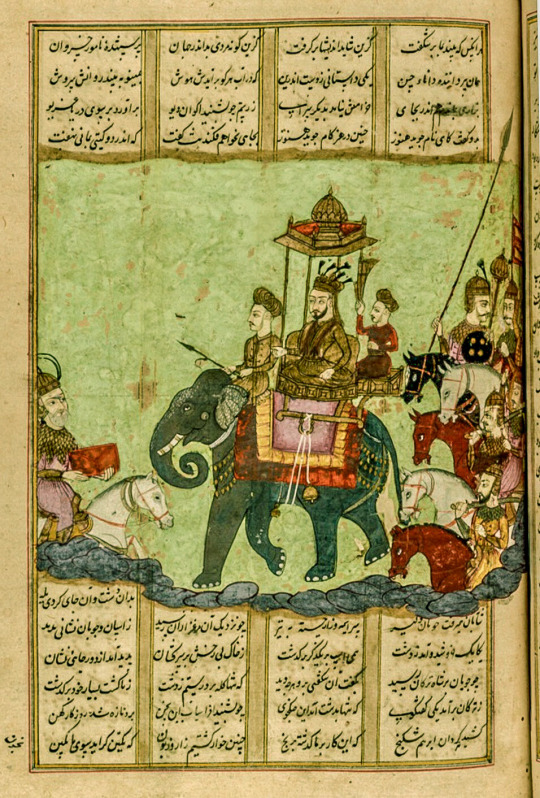
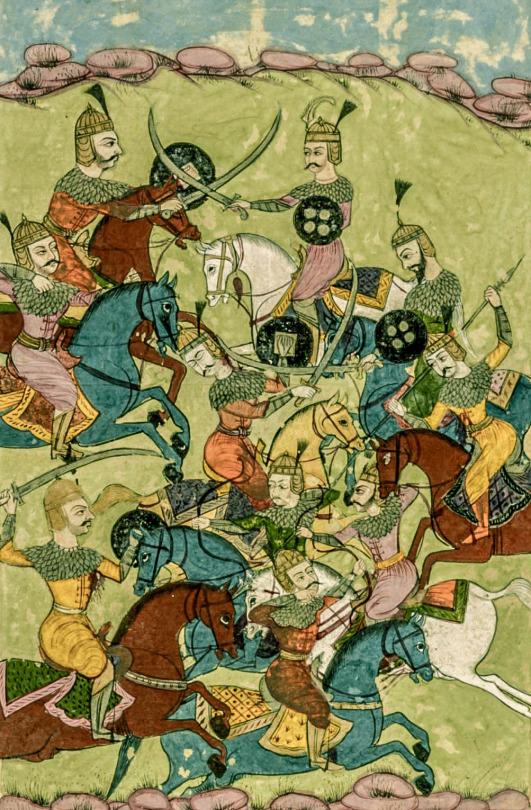
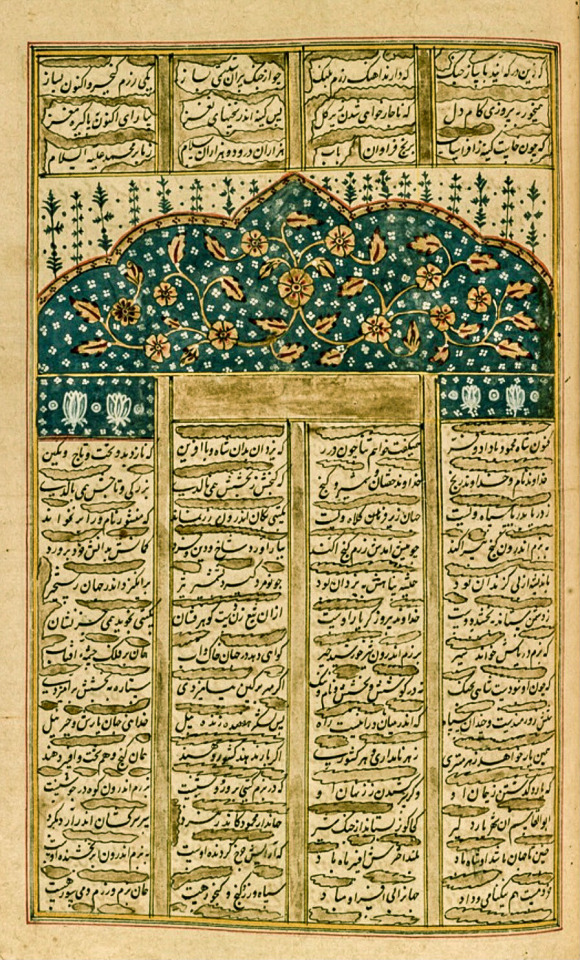



source [The Library of Congress]
#beautiful books#book blog#books books books#book cover#books#illustrated book#old books#incunabula#mythology and folklore#ancient persia
69 notes
·
View notes
Text
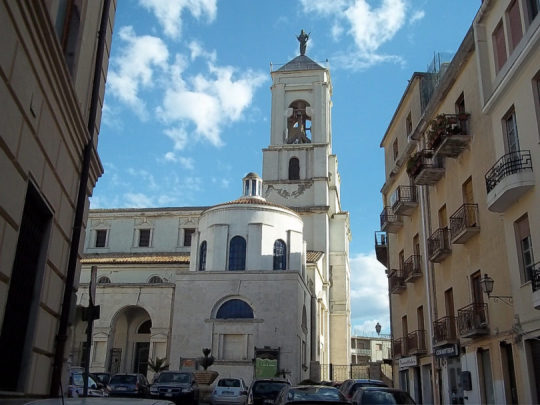

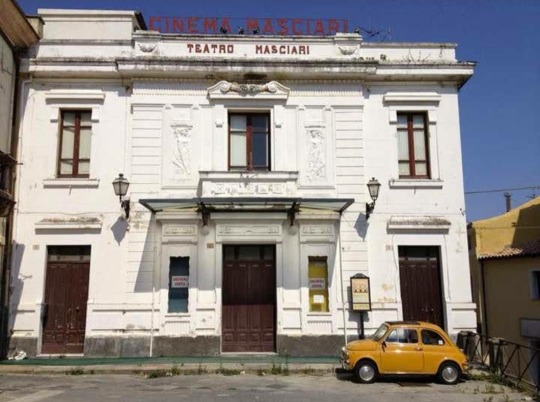
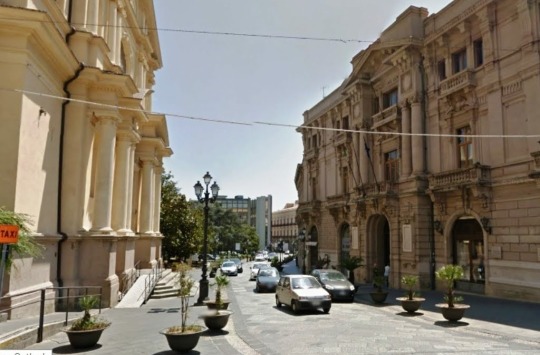

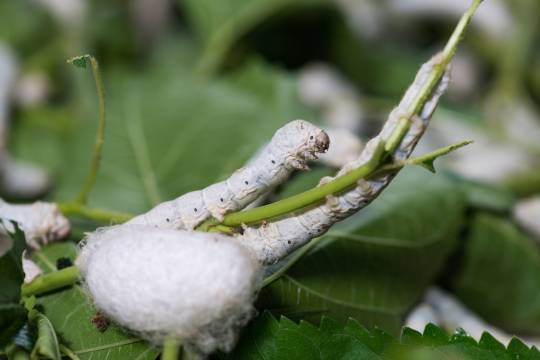
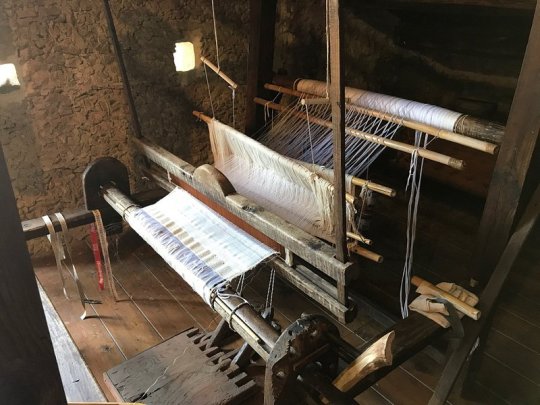
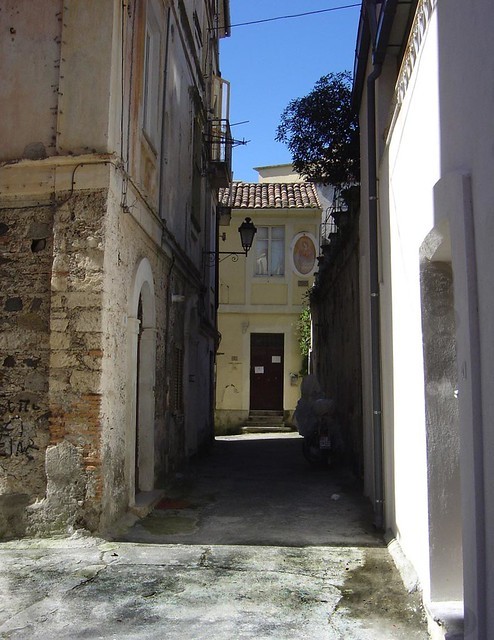
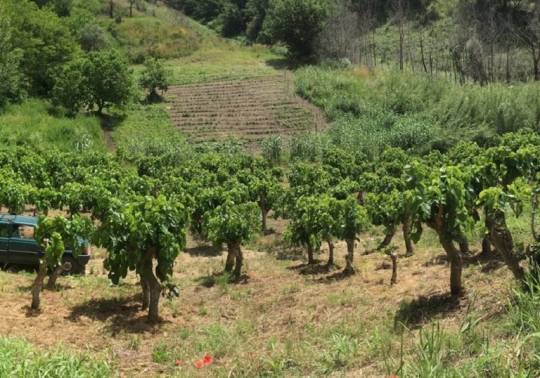
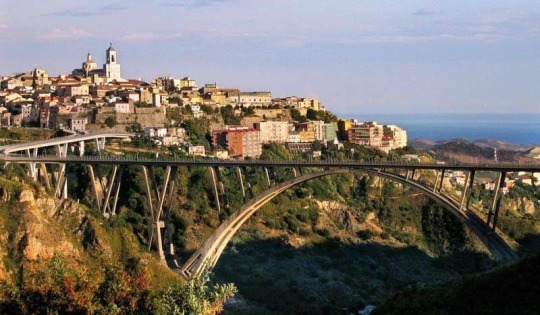
Catanzaro, Calabria, Italy
This ancient town which rises on a rock is the capital of the Calabria region. It was founded in 9th century by the Byzantines and was built over three hills in order to protect the town from the Saracen attacks arriving from the lonian sea.
At the beginning of the tenth century (c. 903), the city of Catanzaro was occupied by the Muslim Saracens, who founded an emirate and took the Arab name of قطنصار - Qatanşār.
An Arab presence is evidenced by findings at an eighth-century necropolis which had items with Arabic inscriptions. Around the year 1050, Catanzaro rebelled against Saracen dominance and returned to a brief period of Byzantine control.
Under the Byzantine dominion, between the end of the 9th and the beginning of the 10th century, Calabria was one was one the first places in Italy to introduce the breeding of the silkworm in the 11th century.
According to French historian André Guillou, mulberry trees for the production of raw silk were introduced to Calabria by the Byzantines at the end of the 9th century. Mulberry leaves are the only leaves that silkworms eat.
Around 1050, the theme of Calabria had cultivated 24,000, mulberry trees for their foliage, with growth still ongoing.
The peasants of the countryside around the city produced the raw silk, which was then woven in the silk workshops of Catanzaro. A large part of the population was involved in this business, and the silk of Catanzaro supplied almost all of Europe.
The silk was sold in a large market fair in the port of Reggio Calabria, to Spanish, Venetians, Genovese and Dutch merchants.
Today, three young friends have come together to bring local traditions back to the fore. In 2014 they decided to build their future in San Floro, a tiny village of 600 inhabitants near the city of Catanzaro and restore the traditional mulberry tree planting and cultivation needed for the rearing of silkworms. Historically, San Floro was famous for a very significant production of raw silk in the 17th century, though this heritage had been completely lost in modern times.
The only surviving elements of this rich legacy were the 3,000 abandoned mulberry trees and the memory of the elderly villagers. Miriam and her friends brought back the production of silk, rewinding the threads of history and travelling across the world to exchange best practices with silk institutes in Thailand, India, Switzerland, and France.
As part of its development, they trained people interested in their new, sustainable production model and also brought thousands of tourists from all over the world to visit their farm (Nido di Seta) to experience how silk is produced first-hand.
Catanzaro is a windy city due to its altitude and position between two seas. In fact, there is only 30 km separating the Ionian Sea from the Tyrrhenian Sea and Catanzaro is wide open to the constant strong breezes from the Ionian Sea and the Sila mountains.
Follow us on Instagram, @calabria_mediterranea
#catanzaro#calabria#italy#italia#south italy#southern italy#italian#mediterranean#silk#the silkworm#silk road#europe#architecture#textile#loom#mulberry tree#history#muslim#saracens#italian landscape#landscape#mediterranean sea#arab#byzantine#byzantine empire#weaving#nido di seta
20 notes
·
View notes
Photo

Portuguese Cochin
Cochin, located on the southwest coast of India, was a Portuguese colony from 1503 to 1663. Known to the Portuguese as Cochim, it was one of several important cities on India’s Malabar Coast and a great trade centre for spices like pepper. Cochin was the administrative capital of Portuguese India until it was replaced by Goa in 1530.
A fort was built at Cochin in 1503, the first in Portuguese India, as the Europeans used the city as their first headquarters in the East. The great explorer Vasco da Gama (c. 1469-1524) spent his last days in the city, and it remained a lucrative hub of the spice trade into the 17th century. The city was taken over by the Dutch in 1663, then the English in 1814, and finally gained independence with the rest of India in 1947. Today, the city is known as Kochi and is the most prosperous port in the Kerala region of India.
Vasco da Gama
In the 15th century, the Portuguese colonization of Madeira in the North Atlantic from 1420 was the first in a series of colonial stepping stones that eventually led to India. The treacherous Cape Bojador in West Africa was negotiated in 1434, the Azores were colonised from 1439, Cape Verde from 1462, and São Tomé and Principe from 1486. In 1488 Bartolomeu Dias sailed down the coast of West Africa and made the first voyage around the Cape of Good Hope, the southern tip of the African continent (now South Africa).
The famed Portuguese explorer Vasco da Gama followed in Dias’ wake and pioneered a maritime route from Portugal to India when in 1497-9, he sailed around the Cape of Good Hope, went up the coast of East Africa, and crossed the Indian Ocean to arrive at Calicut (now Kozhikode) on the south-west coast of India. His voyage, supported by King Manuel I of Portugal (r. 1495-1521), was intended to find a legendary Christian kingdom in the East and to give Portugal direct access to the Eastern spice trade and cut out the Arab middlemen traders. The first aim ended up being an illusion but the second was indeed achieved. For the first time, Europe could access by sea a trade which had been going on for centuries but which channelled luxury goods through the Red Sea and the Persian Gulf to be then taken by camel caravan to the Mediterranean. Such goods as pepper, ginger, cloves, and cinnamon were immensely popular in Europe and expensive.
Vasco da Gama, through a mix of inexperience, lack of trade goods, and Indian confidence in the status quo, failed to establish friendly trading relations with Calicut. A second Portuguese expedition, this time with 13 ships and 1500 men and commanded by Pedro Álvares Cabral, set off to repeat da Gama’s feat in March 1500 and was given the brief of muscling-in on Muslim trade by sinking any Arab ships they came across. Vasco da Gama sailed for a second time to India in 1502-3, this time with 15 ships. A result of this voyage was more trouble with the ruler of Calicut, but a trade treaty was agreed with Cochin further down the coast.
Continue reading...
17 notes
·
View notes
Text

Kordofan melons from Sudan are the closest relatives and may be progenitors of modern, cultivated watermelons. Wild watermelon seeds were found in Uan Muhuggiag, a prehistoric site in Libya that dates to approximately 3500 BC. Watermelons were domesticated in north-east Africa, and cultivated in Egypt by 2000 BC, although they were not the sweet modern variety. Sweet dessert watermelons spread across the Mediterranean world during Roman times.
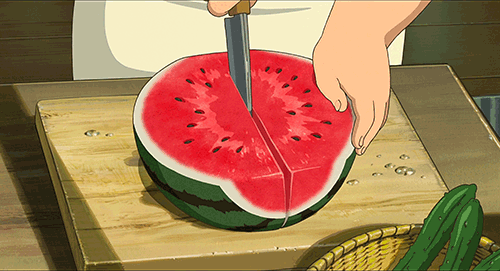
Many 5000-year-old wild watermelon seeds (C. lanatus) were discovered at Uan Muhuggiag, a prehistoric archaeological site located in southwestern Libya. This archaeobotanical discovery may support the possibility that the plant was more widely distributed in the past.
In the 7th century, watermelons were being cultivated in India, and by the 10th century had reached China. The Moors introduced the fruit into the Iberian Peninsula, and there is evidence of it being cultivated in Córdoba in 961 and also in Seville in 1158. It spread northwards through southern Europe, perhaps limited in its advance by summer temperatures being insufficient for good yields. The fruit had begun appearing in European herbals by 1600, and was widely planted in Europe in the 17th century as a minor garden crop.
Early watermelons were not sweet, but bitter, with yellowish-white flesh. They were also difficult to open. Through breeding, watermelons later tasted better and were easier to open.
European colonists and enslaved people from Africa introduced the watermelon to the New World. Spanish settlers were growing it in Florida in 1576. It was being grown in Massachusetts by 1629, and by 1650 was being cultivated in Peru, Brazil and Panama. Around the same time, Native Americans were cultivating the crop in the Mississippi valley and Florida. Watermelons were rapidly accepted in Hawaii and other Pacific islands when they were introduced there by explorers such as Captain James Cook. In the Civil War era United States, watermelons were commonly grown by free African people and became one symbol for the abolition of slavery. After the Civil War, African people were maligned for their association with watermelon. The sentiment evolved into a racist stereotype where Africn people shared a supposed voracious appetite for watermelon, a fruit long correlated with laziness and uncleanliness.
Seedless watermelons were initially developed in 1939 by Japanese scientists who were able to create seedless triploid hybrids which remained rare initially because they did not have sufficient disease resistance. Seedless watermelons became more popular in the 21st century, rising to nearly 85% of total watermelon sales in the United States in 2014

A melon from the Kordofan region of Sudan – the kordofan melon – may be the progenitor of the modern, domesticated watermelon. The kordofan melon shares with the domestic watermelon loss of the bitterness gene, while maintaining a sweet taste, unlike other wild African varieties from other regions, indicating a common origin, possibly cultivated in the Nile Valley by 4360 BP (before present)

#kemetic dreams#watermelon#wow#kordofan#sudan#ta seti#nubia#progenitor#nile valley#african#afrakan#africans#libya#north africa#african culture#north ifriqiya#ifriqiya#kordofan melon
24 notes
·
View notes
Text

Christmas Punch
Some point to the ancient Hindustani word "paanstch", which means five: a great drink prepared from five key elements - sweet, sour, alcohol (arrak), water and spices. Some, however, attribute it to English merchant sailors who, though they did not invent the punch, very much drank it. Men working on British East India Company ships used it as a beer alternative in the 17th century. The sailors were known to consume large quantities of beer on their voyages, but when the ships reached the warmer waters of the Indian Ocean, the beer in the cargo bays became rancid and stale. Once the ships reached the coast, the sailors created new drinks from ingredients native to their destination: Arrack, citrus fruits and spices. Back at sea or at home, rum or brandy or other wines were more likely to be used.

Naval Officers and a Bowl of Punch by Thomas Rowlandson c.1790 (x)
The sailors brought punch back with them to Britain. With its exotic flavours and expensive ingredients, it became a fixture in the elite homes of 17th-century England and then a staple. Some parties, however, tended to get out of hand. Like the celebration of Edward Russel, captain-general and commander in chief in the Mediterranean. On 25 October 1694 he had a garden party for 6000 guests in his villa, and had his marble fountain filled with punch. For this, 4 hogsheads (c. 960l) of brandy, 8 hogsheads of water, 25000 lemons 75l of lime juice. 560kg of sugar, 3kg of nutmeg, 300 toasted biscuits and a pipe of dry mountain Malaga. The punch was served by a ship's boy who rowed through the fountain in a small boat.
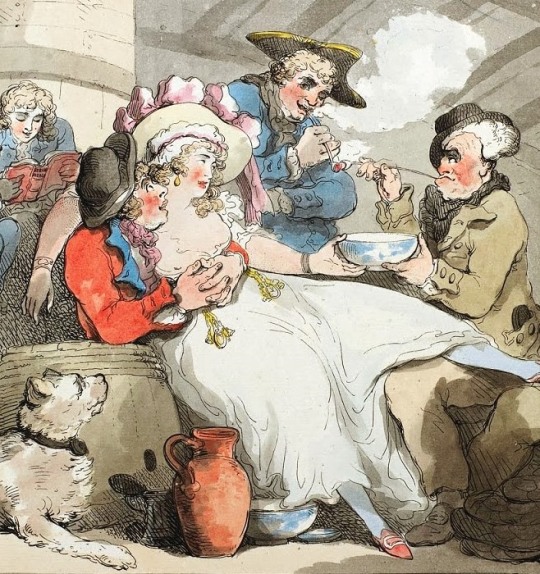
Sailors sharing both punch and wenches. Taken from “Grog on Board” by Thomas Rowlandson, 1789 (x)
Punch entered the middle class as ingredients became more affordable during the 18th century. Punch was ubiquitous in the British Atlantic world and spread to the American colonies. So why is it considered more of a Christmas drink. It was because many of the merchants stayed at home during the winter months and made punch for the family on Christmas Day with the spices they had bought for themselves locally. This made it something special and is therefore often associated with the Christmas season, even though it was served all year round, especially when the spices became affordable for many.
And if you want to make now your own punch here is a nice recipe.
Bombay Presidency Punch in Bombay Government, August 13, 1694
Servings: 2
Prep Time: 5 minutes
2 Tbsp sugar
2 Tbsp lime or lemon juice
1/2 cup rum
3/4 cups water
nutmeg
In a non-reactive bowl or pitcher, mix together the sugar and the juice and stir until dissolved. (Please use a glass, pottery, or stainless steel bowl or pitcher. Copper, cast iron, and aluminum will react with the acid in the lemon juice.)
Remove any seeds that may have made their way into the bowl. Blend in the rum, and then the water.
Add ice. Then grate nutmeg over the top.
Enjoy your tipple!
73 notes
·
View notes
Photo


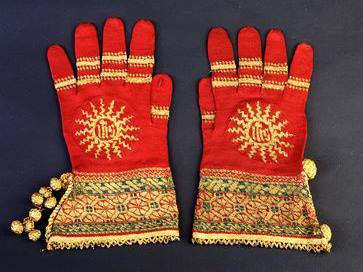
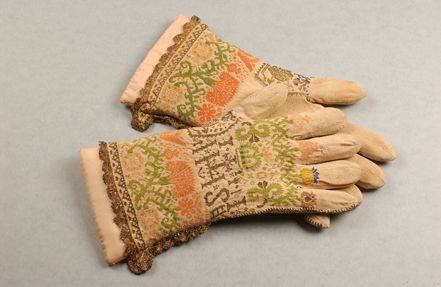
No 1. 17 c. Glove “from the stores of the Nizam of Hyderabad.” India. Fine wool.
No 2. Fray Agustin L贸pez. Silk. s. XVII.
No 3. All I know is they are Swedish.
No 4. Knitted silk, 17th/18thC. The Worshipful Company of Glovers of London.
40 notes
·
View notes
Text

Good morning! I hope you slept well and feel rested? Currently sitting at my desk, in my study, attired only in my blue towelling robe, enjoying my first cuppa of the day. Welcome to Too Much Information Tuesday.
37% of the web is porn.
Sex burns 360 calories per hour.
Baths kill more people than terrorists.
Earth has lost 50% of its wildlife in the past 40 years.
The big bang was quieter than a Motorhead concert.
Men are biologically hardwired to fall asleep after sex.
100,000 Japanese people disappear without trace every year.
The brain naturally craves four things: food, sex, water and sleep.
A blue whale can swallow half a million calories in a single mouthful.
The literal meaning of “Once in a blue moon” is once every 2.7 years.
The number of emails is expected to reach 376 billion daily by 2025.
In North Korea, the sentence for getting caught watching porn is death.
Being alone weakens your body. Having friends strengthens your body.
British people inserting things up their bums costs the NHS £350,000 a year.
The Peter Principle holds that people are always promoted beyond their ability.
Studies show that the average man exaggerates the length of his penis by 20%.
In 1997, Bill Gates invested $150 million in Apple to save it from going bankrupt.
According to a 2014 study, shorter men report that they have more sex. (No comment.)
On average people are 2 inches shorter and 20% poorer than they claim to be online.
Friendship has more influence on longevity than exercise, diet, heart problems and smoking.
In 1973, China had an excess of females and offered the U.S. 10 million Chinese women.
In 2011, a lorry crashed on the M1 spilling enough Marmite to cover 24 million slices of toast.
Eminem wrote and recorded ‘The Real Slim Shady’ three hours before his album was due.
To test what happens when someone sits on their phone, Samsung has a robot shaped like a bottom.
India used to be the richest country in the world until the British invasion in the early 17th Century.
In 2006, Liechtenstein accidentally found 0.3% more of their country when they remeasured their borders.
The more you hide your feelings, the more they show. The more you deny your feelings, the more they grow.
A study has found that friends-with-benefits relationships are just as sexually satisfying as marital relationships.
Marrying your best friend eliminates the risk of divorce by over 70%. These marriages are more likely to last a lifetime.
According to new research, your cat will happily take treats from your enemies. Your dog, however, will not.
At the 1968 Olympics, Bob Beamon broke the long jump record by so much they had to find another tape measure.
Emotional pain lasts for 10 to 20 minutes, anything longer is actually self-inflicted by over thinking, making things worse.
In 1900, Sir Arthur Conan Doyle caught fire during a cricket match at Lord's. The ball hit a box of matches in his pocket.
You may gain 20% more muscle strength by working out in the afternoon instead of the morning, according to a study.
According to the World Health Organization (WHO), an estimated 619,000 people die each year due to heat stroke.
‘The Shawshank Redemption’ has been rated the best movie of all time according to IMDb, with a rating of 9.2/10.
There are 67.1 million tracks sitting on music streaming services that, in the 2022 calendar year, attracted 10 or fewer streams.
Alfred Hitchcock, the master of suspense, who terrified audiences with movies like ‘Psycho’ and ‘The Birds’ was frightened of eggs.
The most expensive movie ever made is ‘Pirates of the Caribbean: On Stranger Tides’ (2011) with a budget of $378.5 million.
When pirate Jean Lafitte (c. 1780 – c. 1823) saw that the governor of Louisiana had offered $500 for his successful capture, Lafitte put up flyers offering $1500 for the capture of the governor.
A ‘binfluencer’ is a person on a street who takes the lead in putting out the correct waste and recycling bins on the correct day, thus prompting neighbours to follow suit. (My next door neighbour is one!)
Okay, that’s enough information for one day. Have a tremendous and tumultuous Tuesday! I love you all.
#mixcloud#mi soul#dj#music#new blog#lockdown#coronavirus#books#democracy#brexit#cronyism#election#tuesdaymotivation#radio
18 notes
·
View notes
Text

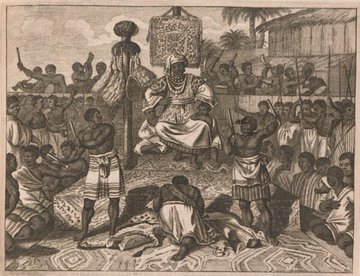

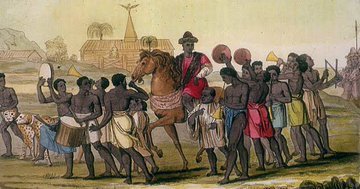
AFRICA WAS DESTROYED WHEN ARABS AND EUROPEANS FIRST STEPPED FOOT ON HER SOIL. "All of the countries named as Underdeveloped in the world are exploited by others. And underdevelopment to which the world is preoccupied is a product of capitalist, imperialist and colonial exploitation." - Walter Rodney (How Europe Underdeveloped Africa). When the Europeans came to Whydah, they found a thriving kingdom with its own institutions, political system and a network of trading relations between Dahomey and other West African kingdoms like the Benin Empire in what is modern-day Nigeria. Benin, for instance, had been trading with Dahomey since the early 17th century CE and the Ashanti kingdom in the following centuries, even before both Ashante and Dahomey became a strong polity to be reckoned with. Benin empire had before then, been trading on the West African Coast since the 11th century CE. These trade relations were shattered by first, the Portuguese, then the British and the French; with the sole intention that all African policies should no more be trading among each other but that they should all depend slavishly on Europe. To this end, Europe was most successful and the effects can still be felt today. So much so that some African countries today, imports toothpicks from Europe...and toothpick is the simplest thing, anyone can make. The Europeans were welcomed with traditional African hospitality, because according to Historian Dr John Henrik Clarke, "no one would have imagined that the welcomed guests will enslave the man of the house and the woman who cooked the meal." No one would have, indeed, imagined that. Another thing the African kings did not know was that the European trading(and later looting and plundering) corporation had an active army that was more than that of some countries. For example, the British East Indian trading corporation under Colin Mackenzie in the 1800s, that took over India(especially the kingdom of Virjayanangra in southern India) had such an army. The Dutch East Indian Company had such an army too. One of the successful transactions of such a trading corporation was when the entity became northern protectorates and southern protectorates of the British along the Niger River (which was later amalgamated by the British in 1914 CE to form Nigeria after a series of wars and manipulations), was bought by the British from the Royal Niger company for an amount of about 850 hundred pounds, some sources indicated the amount to have been in thousands of pounds. No African was part of this transaction. And in this way, it was like a 'mafia don who had taken over a territory, selling what wasn't his to another mafia don.' The British(descendants of the European barbarian tribe, the Angles-Saxons) claimed this territory as their own property, just as the French(descendants of the European barbarian tribe known as the Franks) took over Dahomey in 1894 CE. This had come at a huge price for the Africans. First, the visitors were allowed room in the coastal areas and they brought in an invisible enemy; alien diseases like gonorrhoea, syphilis, smallpox and other germs causing ailments that the Africans were not immune to. Next was slavery which was followed closely by colonialism that shattered African ancient polities to this very day. And why Europeans were busy with this 'enterprise,' Arabs were busy in the Sahel, North Africa and East Africa, placing a 'knife on everything that had held the societies together, even before there was a Europe or an Arab in existence. This knife was Mohammedanism or Islam, and it has confused the Africans to this very day. (C: THE HISTORY OF AFRICA MAGAZINE '22) #Africa
5 notes
·
View notes
Text

"Yogini with a mynah bird" by the Dublin Painter. Bijapur, early 17th century
50 notes
·
View notes
Text
#FantasyFriday anyone? Check out this amazing 17th c. Mughal miniature painting!



A floral fantasy of animals & birds (Waq-waq)
early 1600s
India, Mughal
Gum tempera & gold on paper
37.6 x 26.6 cm (14 13/16 x 10 1/2 in.)
Cleveland Museum of Art
"Derived ultimately from a conflation of medieval Persian and Qur'anic sources, including descriptions of the mythical island of Waq-waq inhabited by half-plant/half-animal creatures, this extraordinary painting depicts a plant that brings forth animal life in multiple forms. Playfully rendered with animals both real and mythic and birds that seem to effervesce away as they break free of the stems, this brilliant rendition of a life-giving plant maintains its compositional integrity, even as it sprawls across the page. This painting was made to beguile courtly connoisseurs who would gather to admire the wondrous images in an imperial album."
#Indian art#Mughal art#Islamic art#animals in art#birds in art#mammals#birds#dragons#mythical creatures#hybrid creatures#plants#painting#miniature painting#South Asian art#Asian art#17th century art#Cleveland Museum of Art#Waq-waq#Fantasy Friday
42 notes
·
View notes
Text

Rooster
c. 1620
India, Mughal, 17th century
Opaque watercolor and gold on paper
This bird, with its fierce expression, sharp beak, and spurred feet, may have been a champion in the cockfighting ring. The Mughal emperor Jahangir requested that his royal court artists paint portraits of remarkable birds and animals with as much realism as possible. He felt that such paintings enhanced feelings of amazement beyond hearing or reading an account.
Cleveland Museum of Art
37 notes
·
View notes
Text
HISTORY OF TAMIL NADU
Name :Sanjith Y
Dep:B A HISTORY(EM)
REG NO:2121E0246
EMAIL ID: [email protected]
The history of Tamil Nadu is rich and diverse, spanning thousands of years. While it's challenging to cover its entire history in just 1000 words, I can provide a concise overview of key periods and developments.
1. **Ancient History (300 BCE - 300 CE):**
Tamil Nadu's history can be traced back to the Sangam period, characterized by the flourishing of Tamil literature. The Sangam texts, composed between 300 BCE and 300 CE, provide insights into the early Tamil society, culture, and politics.
2. **Medieval Period (7th - 14th Century):**
The Chola dynasty, one of the most prominent in Tamil Nadu's history, ruled during this time. They expanded their empire across South India and Southeast Asia. The Cholas made significant contributions to art, literature, and temple architecture.
3. **Vijayanagara Empire (14th - 17th Century):**
The Vijayanagara Empire, although not Tamil, influenced the region. They promoted the growth of the Tamil language and culture. Temples and grand architectural projects were undertaken during this period.
4. **Nayak and Maratha Rule (17th - 18th Century):**
After the decline of the Vijayanagara Empire, Tamil Nadu saw the rise of various Nayak dynasties and later, the Marathas. The Nayaks continued to promote Tamil culture and literature.
5. **British Colonial Rule (18th Century - 1947):**
The British East India Company established control over Tamil Nadu in the 18th century. The region played a crucial role in the Indian independence movement. Prominent leaders like C. Rajagopalachari and Periyar E.V. Ramasamy emerged during this period.
6. **Independence and Post-Independence Era (1947 - Present):**
India gained independence in 1947, and Tamil Nadu played a significant role in the formation of the Indian Republic. The state has been politically active, with the Dravidian movement advocating for regional autonomy and social reform.
7. **Cultural Heritage:**
Tamil Nadu has a rich cultural heritage, including classical dance forms like Bharatanatyam, traditional music, and a vibrant literary tradition. Temples like the Brihadeeswarar Temple in Thanjavur and the Meenakshi Temple in Madurai are architectural marvels.
8. **Language and Literature:**
Tamil is one of the oldest surviving classical languages in the world. It has a vast body of literature, including the Sangam poetry, religious texts, and modern works by literary giants like Subramania Bharati and Kalki Krishnamurthy.
9. **Economy and Industrialization:**
Tamil Nadu has a diverse economy, with sectors like manufacturing, agriculture, and services playing crucial roles. The state has become an industrial hub with a focus on automotive manufacturing and information technology.
10. **Political Landscape:**
The state has been known for its dynamic and competitive politics. Dravidian parties, the DMK (Dravida Munnetra Kazhagam) and AIADMK (All India Anna Dravida Munnetra Kazhagam), have dominated the political scene. Key leaders include M.G. Ramachandran, M. Karunanidhi, and J. Jayalalithaa.
11. **Social Reforms:**
Tamil Nadu has a history of social reform movements, addressing issues like caste discrimination and women's rights. Figures like Periyar E.V. Ramasamy played pivotal roles in these movements.
12. **Education and Science:**
Tamil Nadu is known for its educational institutions like the Indian Institute of Technology (IIT) Madras and the Indian Institute of Management (IIM) Trichy. It has contributed significantly to fields such as science, technology, and healthcare.
13. **Cinema:**
The state is a hub for the Indian film industry, with the Tamil film industry, or "Kollywood," producing a vast number of films. Superstars like Rajinikanth and Kamal Haasan have gained international recognition.
14. **Recent Developments:**
Tamil Nadu has witnessed various infrastructural developments, including metro rail projects, and has continued to focus on economic growth and social welfare.
In summary, Tamil Nadu's history is a tapestry of ancient civilizations, colonial influence, political movements, cultural richness, and economic progress. Its legacy continues to shape the social, political, and cultural landscape of modern India.
2 notes
·
View notes
Text
#unhallowedarts - The Flying Dutchman
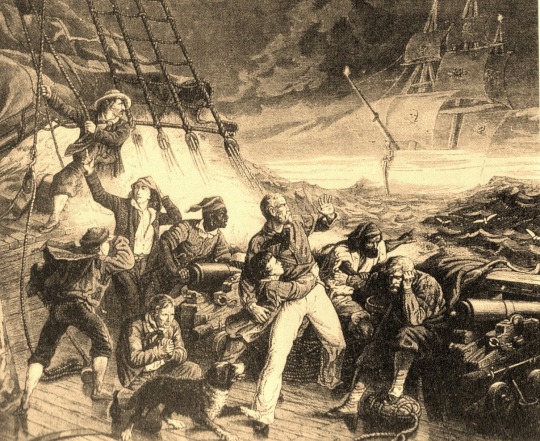
“You certainly know the fable of the Flying Dutchman. It is the story of an enchanted ship which can never arrive in port, and which since time immemorial has been sailing about at sea. When it meets a vessel, some of the unearthly sailors come in a boat and beg the others to take a packet of letters home for them. These letters must be nailed to the mast, else some misfortune will happen to the ship—above all if no Bible be on board, and no horse-shoe nailed to the foremast. The letters are always addressed to people whom no one knows, and who have long been dead, so that some late descendant gets a letter addressed to a far away great-great-grandmother, who has slept for centuries in her grave. That timber spectre, that grim grey ship, is so called from the captain, a Hollander, who once swore by all the devils that he would get round a certain mountain, whose name has escaped me, in spite of a fearful storm, though he should sail till the Day of Judgement. The devil took him at his word, therefore he must sail for ever, until set free by a woman's truth. The devil in his stupidity has no faith in female truth, and allowed the enchanted captain to land once in seven years and get married, and so find opportunities to save his soul. Poor Dutchman! He is often only too glad to be saved from his marriage and his wife-saviour, and get again on board.“ (Heinrich Heine)
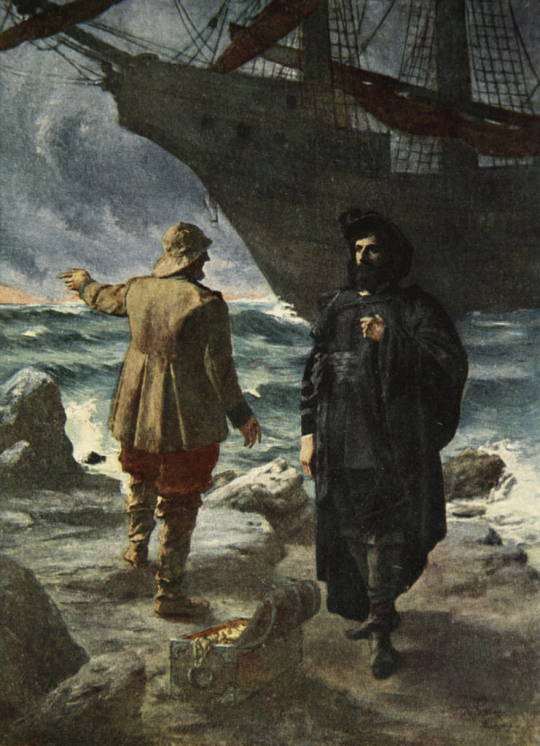
Ferdinand Leeke "The Flying Dutchman" (c 1905)
Naturally, Washington Irving naturalised him, quitting the Good Hope and sailing tof New Amsterdam to find redemption, the Flying Dutchman, Captain Vanderdecken, Tyn van Straten, van Diemen, van Evert, van Halen or Bernard Fokke of the VOC, the 17th century Dutch East India Company. Legend has it that he struck a with the devil to make the Java run in half the usual time. That he used iron yardarms, allowing him to have as much canvas aloft as possible, even when the feared Southeaster whipped the waters around the Cape that broke wooden spars on a regular basis – mere trivialities. He was, however, cursed to sail until Judgement Day, after he swore into the storm he would do exactly that until he rounded the Good Hope on his last voyage. The one he never returned from.
Ever since, his fluyt is seen in the Southern hemispheres, East of the Cape, with red sails flying in the sunset or bathed in a eerie red light, a portent of doom for those whose bows she crosses. Rich tales that not only inspired imaginative mariners, but professional storytellers as well, from Coleridge and Walter Scott to Hauff and Wagner and cohorts of 20th century journalists and pulp fiction writers. Ever since the 18th century. With the one from 1881 being the most prominent sighting, when HM frigate “Inconstant” encountered the Flying Dutchman with H future M George V on board, no less, who recorded in his log:
“July 11th. At 4 a.m. the Flying Dutchman crossed our bows. A strange red light as of a phantom ship all aglow, in the midst of which light the masts, spars and sails of a brig 200 yards distant stood out in strong relief as she came up on the port bow, where also the officer of the watch from the bridge clearly saw her, as did the quarterdeck midshipman, who was sent forward at once to the forecastle; but on arriving there was no vestige nor any sign whatever of any material ship was to be seen either near or right away to the horizon, the night being clear and the sea calm. Thirteen persons altogether saw her ... At 10.45 a.m. the ordinary seaman who had this morning reported the Flying Dutchman fell from the foretopmast crosstrees on to the topgallant forecastle and was smashed to atoms. “
There is, however, a later variant of the damned Dutch skipper’s tale, as told by Heine quoted above, the one that allows him to come ashore once every seven, ten or even hundred years, Brigadoon-like, and find a girl willing to love him, die with him and thus redeem the Flying Dutchman. Wagner famously elaborated on this version in the early 1840 after a rough but rather inspiring sea voyage, after reading Heine and being on the run from his creditors. Wagner made port in Norway twice. Where his Dutchman finds Senta who loves and dies for him and both finally ascend from the seas to heaven. Redemption. Since the last confirmed sighting of the “Flying Dutchman” was recorded in 1959 off Table Mountain, one must assume this is an operatic fable, though.
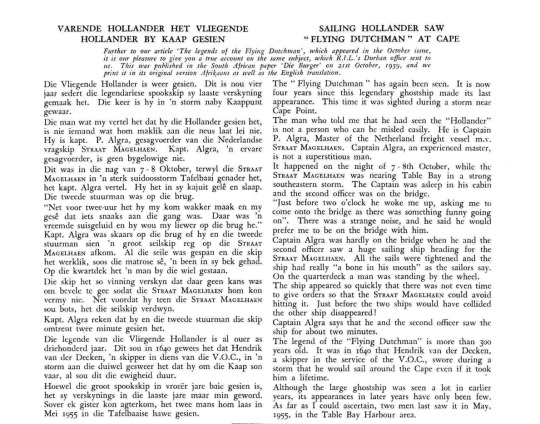
Contemporary Newspapers Clipping Reporting the Sighting of the "Flying Dutchman"
Heinrich Heine's Wagner- and yours-truly-inspiring aperçus from"The Memoirs of Herr von Schnabelewopski" can be read in full below:
#unhallowedarts#dark literature#dark aesthetic#dark art#ghost ship#folklore#dark folklore#flying dutchman#heinrich heine
17 notes
·
View notes